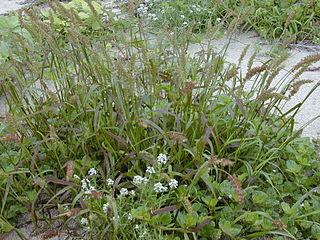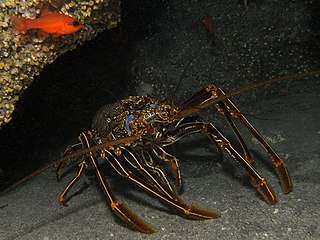
Pterocarpus is a pantropical genus of trees in the family Fabaceae. It belongs to the subfamily Faboideae, and was recently assigned to the informal monophyletic Pterocarpus clade within the Dalbergieae. Most species of Pterocarpus yield valuable timber traded as padauk, usually pronounced or ; other common names are mukwa or narra. The west African species may be traded as African rosewood. P. santalinus also yields the most precious red sandalwood in China known as Zitan. The wood from the narra tree and the Burmese padauk tree is marketed as amboyna when it has grown in the burl form. The scientific name is Latinized Ancient Greek and means "wing fruit", referring to the unusual shape of the seed pods in this genus.

Kermes is a genus of scale insects in the order Hemiptera. They feed on the sap of oaks; the females produce a red dye, also called "kermes", that is the source of natural crimson. The word "kermes" is derived from Turkish qirmiz or kirmizi, "crimson", deriving itself from Persian *کرمست (*kermest) via Proto-Indo-Iranian *kŕ̥miš, from Proto-Indo-European *kʷŕ̥mis (“worm”).
Tarsomys is a genus of rodent in the family Muridae found exclusively in Mindanao, Philippines. It contains the following species:

The spiny long-footed rat, also known as the Mindanao spiny rat, is a species of rodent in the family Muridae.
Procambarus echinatus, the Edisto crayfish, is a species of crayfish in the family Cambaridae. It is endemic to the drainages of the Salkehatchie River and the south fork of the eponymous Edisto River in South Carolina.

Cenchrus echinatus is a species of grass known by the common names southern sandbur, spiny sandbur, southern sandspur, and in Australia, Mossman River grass. It is native to North and South America.

Cynosurus echinatus is a species of grass known by the common names bristly dogstail grass, rough dog's-tail and hedgehog dogtail. It is native to southern Europe, and it is known in the Americas and Australia as an introduced species and sometimes a noxious weed. An herbicide-resistant strain can be found growing as a weed in canola and wheat fields in Chile. This is an annual grass growing 10 to 50 centimeters tall. The inflorescence is a rounded or oval cluster or series of clusters of spikelets. The fertile spikelet has an awn up to a centimeter long. The awns clumped closely together into a tuft gives the inflorescence its bristly, hairy appearance.

Echinops echinatus, the Indian globe thistle, commonly known as Usnakantaka, is a species of globe thistle, found in India, Pakistan, and Sri Lanka. Indian globe thistle is an erect branched herb about 100 cm high. It has short, stout stems, branching from the base, covered with white cottony hair. Alternately arranged oblong, deeply pinnatifid leaves are 7–12 cm long. Flower heads occur in solitary white spherical balls, 3–5 cm across. Petals of the tiny white disc florets are 5 mm long. Flowers are surrounded by straight, strong, white bristles. Often misidentified with Silybum marianum (L.) Gaertner, it is colloquially known as Camel's thistle.

Parmenini is a tribe of longhorn beetles of the subfamily Lamiinae.

Panulirus echinatus, the brown spiny lobster, is a species of spiny lobster that lives on rocky reefs in the tropical western Atlantic Ocean and central Atlantic Islands.
Microtragus arachne is a species of beetle in the family Cerambycidae. It was described by Francis Polkinghorne Pascoe in 1865. It is known from Australia.
Microtragus basalis is a species of beetle in the family Cerambycidae. It was described by Lea in 1917. It is known from Australia.
Microtragus bifasciatus is a species of beetle in the family Cerambycidae. It was described by Lea in 1917. It is known from Australia.
Microtragus browni is a species of beetle in the family Cerambycidae. It was described by Carter in 1932. It is known from Australia.
Microtragus cristulatus is a species of beetle in the family Cerambycidae. It was described by Per Olof Christopher Aurivillius in 1917 and is known from Australia.
Microtragus luctuosus is a species of beetle in the family Cerambycidae. It was described by Shuckard in 1838. It is known from Australia.
Microtragus multituberculatus is a species of beetle in the family Cerambycidae. It was described by Stephan von Breuning in 1954.
Microtragus senex is a species of beetle in the family Cerambycidae. It was described by White in 1846. It is known from Australia.
Microtragus tuberculatus is an Australian species of beetle in the family Cerambycidae, which was described by Carter in 1934.

Trachyaretaon echinatus is a species of the order of the stick insects native to various Philippine islands.








